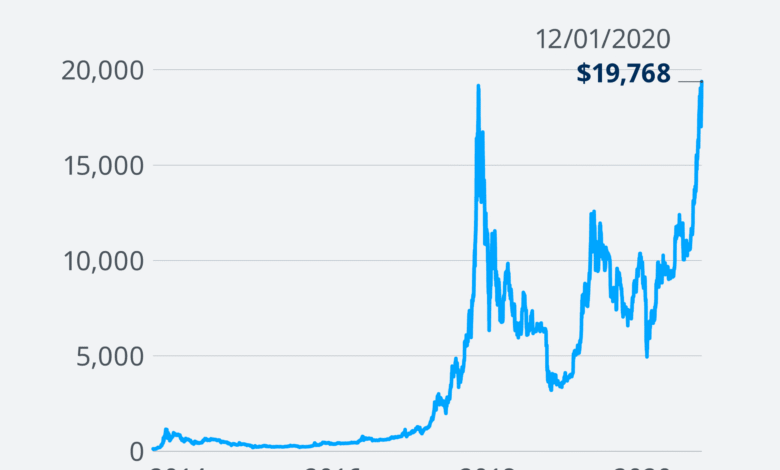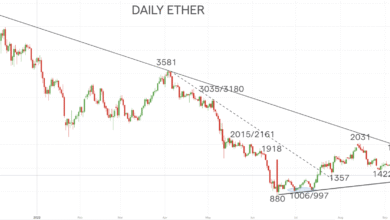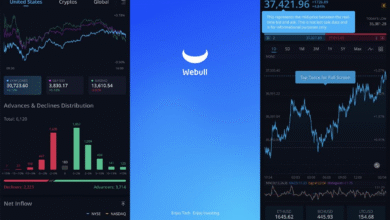Bitcoin Rally Driven by Deficit Spending: Insights Revealed

The recent Bitcoin rally has captivated the attention of investors worldwide, defying traditional market expectations and showcasing the cryptocurrency’s remarkable ability to thrive amidst financial turbulence. This surge in Bitcoin price not only highlights the resilience of digital assets but also reflects the influence of increasing U.S. deficit spending, which has many analysts labeling the market as being in “crisis mode.” Insights from the Kobeissi Letter reveal that Bitcoin gained around $15,000 shortly after a significant spending bill was passed, underscoring a critical moment for institutional investment in Bitcoin. The rapid rise in value is accompanied by growing interest in the cryptocurrency market, offering essential insights for anyone engaged in cryptocurrency market analysis. As Bitcoin continues to soar, investors are keenly observing its trajectory, especially in a landscape fraught with economic uncertainties.
The recent upswing of Bitcoin, often referred to as a ‘digital gold rush,’ has sparked considerable interest not just among traditional investors but also within the evolving landscape of asset management. This unprecedented climb comes at a time when inflationary pressures and governmental fiscal policies are causing a stir in financial circles. As many are dubbing this wave of enthusiasm as a Bitcoin boom, it presents a unique scenario where institutional players are diving into this volatile market, fostering a shift in asset allocation that many believe could alter conventional investment strategies. The ongoing fluctuation in Bitcoin prices has led to a period of adjustment for cryptocurrency enthusiasts and skeptics alike, with each new milestone igniting discussions about the future of digital currencies amid ongoing economic challenges. Such dynamic movements in crypto holdings, influenced by external fiscal factors, underpin a complex narrative that extends beyond mere market speculation.
Bitcoin Rally Driven by U.S. Deficit Spending
The current Bitcoin rally has been heavily influenced by increasing U.S. deficit spending, which has prompted investors to seek refuge in alternative assets. As the U.S. House passed the ‘Big Beautiful Bill,’ market analysts observed a surge in Bitcoin prices, indicating that traditional economic data no longer holds the same weight in this new paradigm. With the dollar losing value and inflation concerns looming, Bitcoin has emerged as a direct alternative for those looking to hedge against potential economic downturns.
This trend of institutional investment in Bitcoin is particularly noteworthy. The Ishares Bitcoin Trust recently hit a historic $76 billion in assets under management, reflecting a growing recognition among institutional investors regarding Bitcoin’s potential as a stable asset during times of deficit spending. This influx of capital, combined with strong media sentiment and bullish market conditions, has solidified Bitcoin’s position in the cryptocurrency market, marking a significant milestone in its evolution as a mainstream financial asset.
How the Cryptocurrency Market Reacts to Traditional Economic Indicators
The relationship between Bitcoin and traditional economic indicators has become increasingly complex. Despite the U.S. dollar’s weakening position and rising deficits, Bitcoin has demonstrated an ability to thrive in what many are calling a ‘crisis mode.’ This unprecedented behavior suggests that Bitcoin may no longer respond to traditional economic fluctuations in the ways investors might expect. Instead, Bitcoin appears to be carving out its own path, increasingly driven by factors within the cryptocurrency market, such as supply dynamics and investor sentiment.
Analysis from The Kobeissi Letter indicates that as institutional investments continue to pour into Bitcoin, traditional asset classes may be affected. The rise in Bitcoin’s popularity among hedge funds, family offices, and even conservative investors seeking alternative asset allocations demonstrates a shift in how capital is moving in response to macroeconomic events. Consequently, the cryptocurrency market is becoming a pivotal player in the global financial landscape, challenging the norms set by traditional economic indicators.
The Abnormality of Bitcoin’s Current Surge
The nature of Bitcoin’s recent price surge has been described as ‘abnormal’ by financial analysts. This observation reflects not only the rapid ascent of Bitcoin’s value but also its concurrent rise with other alternative assets such as gold and increasing yields. The simultaneous climbing of these asset classes hints at a shared investor sentiment: a need for stability amidst economic uncertainty. With Bitcoin gaining approximately $15,000 within just days of the passage of significant deficit spending legislation, the correlation between legislative actions and Bitcoin’s performance has become undeniable.
Furthermore, the concept of Bitcoin in ‘crisis mode’ raises intriguing questions about long-term investment strategies. While the short-term effects of increased deficit spending appear bullish for risky assets, the eventual fallout could lead to a reevaluation of asset classes. Investors and analysts are closely monitoring these shifts, as record-high leverage shorts on Ethereum and similar movements in the crypto space hint at underlying volatility. The stage is set for potential short squeezes that could dramatically alter the landscape of the cryptocurrency market.
Institutional Investment Trends in Bitcoin
Institutional investment into Bitcoin has seen unprecedented growth as the cryptocurrency matures and attracts more attention from large-scale investors. The surge in Bitcoin prices, attributed to the U.S. deficit spending, has created a favorable environment for institutional players to allocate funds more aggressively into the cryptocurrency space. Reports from financial analysts confirm that family offices and hedge funds are increasingly considering Bitcoin as a legitimate asset within their portfolios, with some even daring to commit approximately 1% of their total assets.
Such developments suggest a monumental shift in how the investment community perceives Bitcoin. This trend is further evidenced by the rapid growth of the Ishares Bitcoin Trust, which has successfully attracted billions in assets in a remarkably short period. While some institutional investors remain cautious, many are acknowledging Bitcoin as a hedge against traditional market volatility, thus likely paving the way for a more robust cryptocurrency market moving forward.
Bitcoin Crisis Mode: A Potential Blessing in Disguise?
While the term ‘crisis mode’ may invoke concerns among some investors, analysts from The Kobeissi Letter suggest that this state could actually be beneficial for Bitcoin and other risky assets in the short term. The current environment, characterized by heightened U.S. deficit spending, appears to create opportunities that may lead to sustained price growth for Bitcoin as it gains traction among investors. Market players are expected to capitalize on these conditions, leading to increased buying pressure and possibly a stronger performance overall.
However, the potential long-term consequences of deficit spending remain a critical focus. Analysts caution that while Bitcoin’s current momentum is promising, the eventual ramifications could affect market stability and investor confidence. The challenge will lie in navigating the ‘crisis mode’ to ensure that Bitcoin remains a viable option, not just as a trend, but as a cornerstone of modern financial portfolios amid economic uncertainty.
The Role of Gold in Bitcoin’s Market Performance
Investors have noted a distinct correlation between Bitcoin and gold, particularly as both assets responded positively to traditional economic indicators reflecting instability, such as declining U.S. dollars and rising deficits. The Kobeissi Letter’s analysis highlights this synchronicity, suggesting a broader movement towards alternative assets among risk-averse investors. This dual ascent indicates that Bitcoin’s digitized nature may attract investors in traditional commodities, emphasizing an interconnected investment approach.
Gold’s historical significance as a safe-haven asset makes it an interesting comparison to Bitcoin, particularly during periods of heightened market volatility. As institutional investors increasingly turn to Bitcoin for protection against economic downturns, parallels can be drawn regarding their respective roles within investor portfolios. This evolving relationship between Bitcoin and gold signifies a trend where both assets may serve as complementary hedges, reinforcing the idea of a diversified investment strategy.
Market Analysis: Impacts on Bitcoin Pricing
The current surge in Bitcoin prices has prompted extensive market analysis, particularly concerning how economic indicators and institutional investments sway pricing. Analysts from The Kobeissi Letter have emphasized that this boom, reaching approximately $15,000 shortly after significant governmental spending announcements, reflects a revaluation of Bitcoin in light of pervasive inflationary pressures. The cryptocurrency market index is evolving, suggesting that Bitcoin is not merely a speculative asset but one that is increasingly influenced by macroeconomic policy.
As investors adapt their strategies to incorporate Bitcoin within their portfolios, understanding these price movements is essential. The intertwining of Bitcoin’s performance with more traditional markets implies that institutional investment in Bitcoin may not only bolster its price but create a shift in overall market sentiment. This analysis serves as a reminder for investors to remain informed and agile in a market that is changing rapidly, influenced by both policy decisions and investor psychology.
The Future of Bitcoin Amidst Economic Uncertainty
Looking ahead, the future of Bitcoin appears intertwined with broader economic scenarios, particularly concerning deficit spending and inflation. As institutional investment continues to rise and the cryptocurrency market expands, Bitcoin could potentially solidify itself as a critical asset for diversification strategies. Investors are increasingly tasked with evaluating Bitcoin not merely as a currency but as a financial instrument capable of withstanding economic turbulence.
Economic uncertainty poses challenges, but it also opens doors for Bitcoin’s maturation in the financial sector. The emerging narrative around Bitcoin—a hedge against inflation and economic instability—highlights its potential role in future investment strategies. The interplay between traditional economic indicators and Bitcoin’s performance will define its trajectory, signaling that the age of Bitcoin in the mainstream financial markets may have only just begun.
Understanding the Risks of Bitcoin Investment
Investing in Bitcoin, while potentially lucrative, comes with its own set of risks, particularly as it operates within a volatile market influenced by broader economic conditions. Analysts warn that the recent price surge, characterized by substantial institutional investment and U.S. deficit spending, may attract investors to overlook underlying risks. The cryptocurrency is notorious for its price fluctuations, and external factors, such as government regulation or market sentiment shifts, can heavily impact its performance.
As more investors enter the Bitcoin market, a clear understanding of these risks is essential. The potential for significant changes within the cryptocurrency market could lead to quick market corrections, impacting profit margins for latecomers. By staying informed about current market trends, including the implications of fiscal policies, investors can better navigate the turbulent waters of cryptocurrency investment, ensuring thoughtful and strategic financial decisions.
Frequently Asked Questions
How is the Bitcoin rally driven by U.S. deficit spending affecting the cryptocurrency market?
The recent Bitcoin rally is closely linked to U.S. deficit spending as highlighted by The Kobeissi Letter. An increase in deficit spending has created a favorable environment for Bitcoin, driving its price surge. Investors are moving capital to Bitcoin, perceiving it as a hedge against inflation and economic instability, which reinforces the bullish Bitcoin trend.
What factors contributed to the recent Bitcoin price surge?
The recent Bitcoin price surge has been fueled by several key factors, including significant U.S. deficit spending and increased institutional investment in Bitcoin. As the U.S. Dollar weakens, Bitcoin becomes more appealing to investors, driving its rally higher. Additionally, the rise in gold prices and rising yields also play a crucial role, signaling a shift towards alternative assets.
How does institutional investment affect the Bitcoin rally?
Institutional investment has been a key driver of the Bitcoin rally, with remarkable growth in assets under management for funds like the Ishares Bitcoin Trust. As family offices and hedge funds increase their Bitcoin allocations, this inflow of capital supports the ongoing price surge. The involvement of substantial institutional players signals higher confidence in Bitcoin as an asset class.
What does ‘crisis mode’ mean in the context of the Bitcoin rally?
In the context of the Bitcoin rally, ‘crisis mode’ refers to a situation where traditional economic metrics indicate volatility—such as a weakening U.S. dollar and escalating deficits—while Bitcoin thrives. The Kobeissi Letter suggests that this isn’t necessarily negative for Bitcoin; indeed, risky assets like BTC often perform well during short-term crises as investors seek alternatives.
Can we expect the Bitcoin rally to continue in light of current economic conditions?
While the Bitcoin rally has been impressive, its sustainability may depend on ongoing economic factors such as U.S. deficit spending and market sentiment. Current conditions suggest a strong bullish trend; however, long-term effects of increased deficits could potentially alter this trajectory. Monitoring institutional interest and broader market trends will be crucial for forecasting Bitcoin’s future.
What role does cryptocurrency market analysis play during a Bitcoin rally?
Cryptocurrency market analysis is vital during a Bitcoin rally as it provides insights into market trends, investor behavior, and economic indicators. Analysts like those at The Kobeissi Letter assess the implications of factors such as U.S. deficit spending and institutional investment, helping investors make informed decisions during significant price movements.
What can we learn from the historical performance of Bitcoin during economic downturns?
Historically, Bitcoin has shown resilience during economic downturns, often rallying as investors seek safe havens. The current Bitcoin rally, fueled by U.S. deficit spending, indicates that it may serve as an alternative asset during times of economic instability. By studying past performance, investors can gauge Bitcoin’s potential for growth in similar future scenarios.
| Key Point | Details |
|---|---|
| Bitcoin Surge | Bitcoin gained approximately $15,000 post July 3rd due to a significant spending bill, reaching new heights daily. |
| Market Context | The surge occurred alongside a weakening U.S. dollar (down 11% over six months) and increased interest in gold and yields. |
| Institutional Interest | Ishares Bitcoin Trust (IBIT) reached $76 billion in assets management in under 350 days. |
| Investment Strategy | Institutional investors are increasing allocations, many considering a 1% investment in Bitcoin. |
| Crisis Mode | Bitcoin entered ‘crisis mode’, indicating potential bullish conditions for risky assets despite long-term uncertainties. |
| Short Squeeze Potential | Record-high leverage on ether shorts raises chances of a significant short squeeze in the crypto market. |
Summary
The Bitcoin rally demonstrates a remarkable trend as it diverges from traditional economic indicators, indicating a potential shift in investor sentiment amidst rising U.S. deficit spending. This notable surge, identified by the Kobeissi Letter, highlights significant institutional interest and a possible bullish disposition for risky assets in the short term. Investors should be aware, however, of the long-term implications that such an environment may pose.




